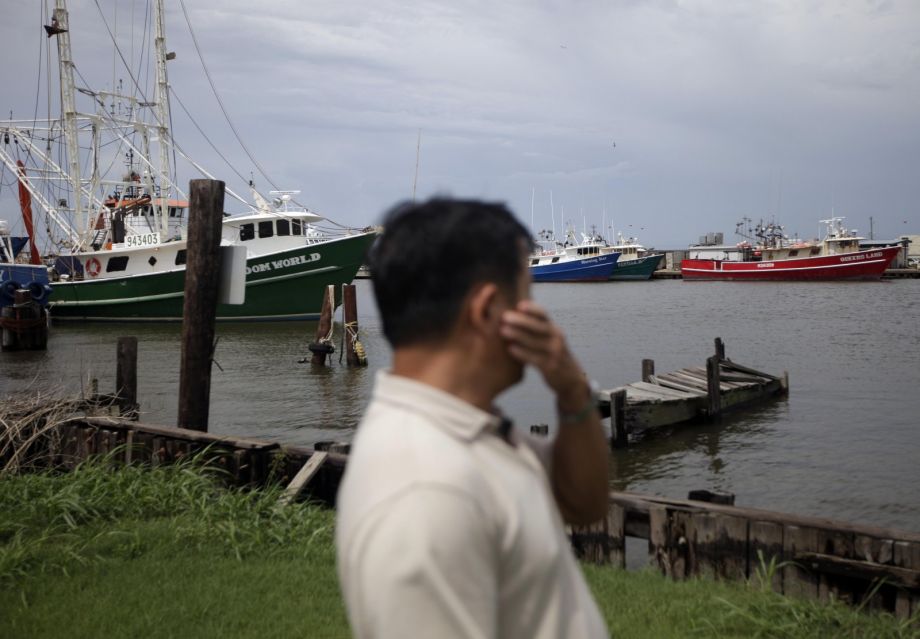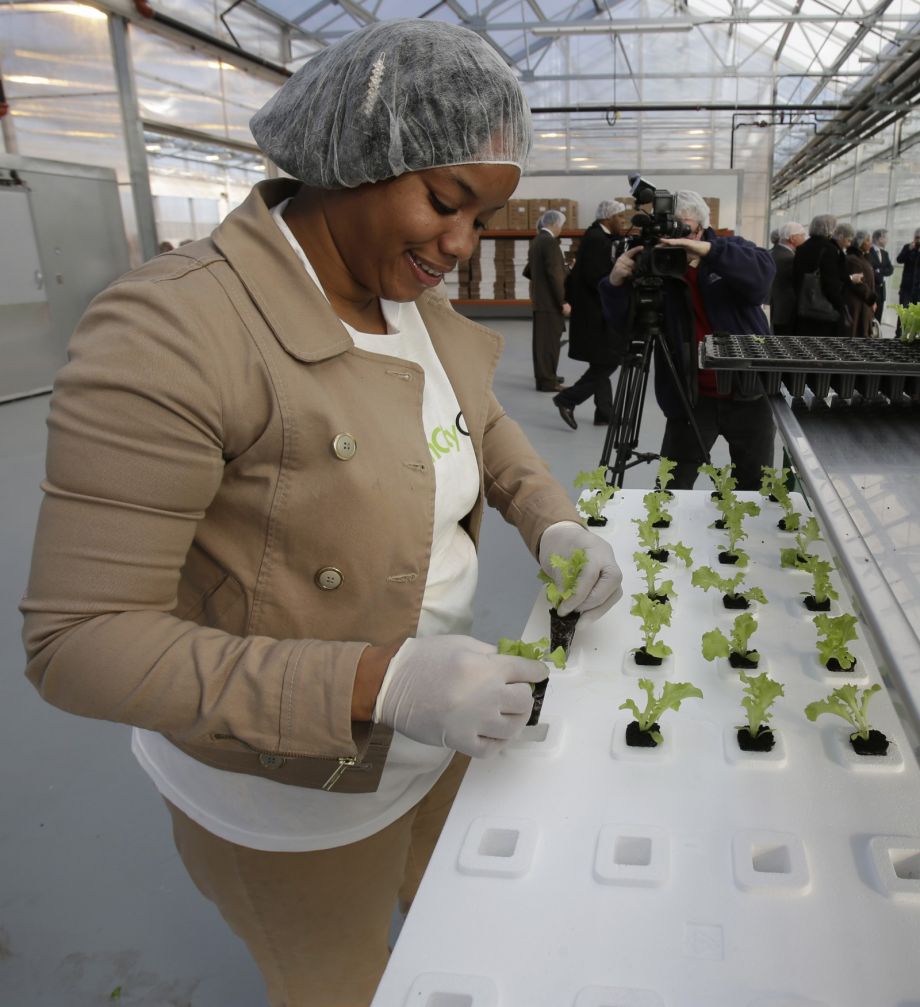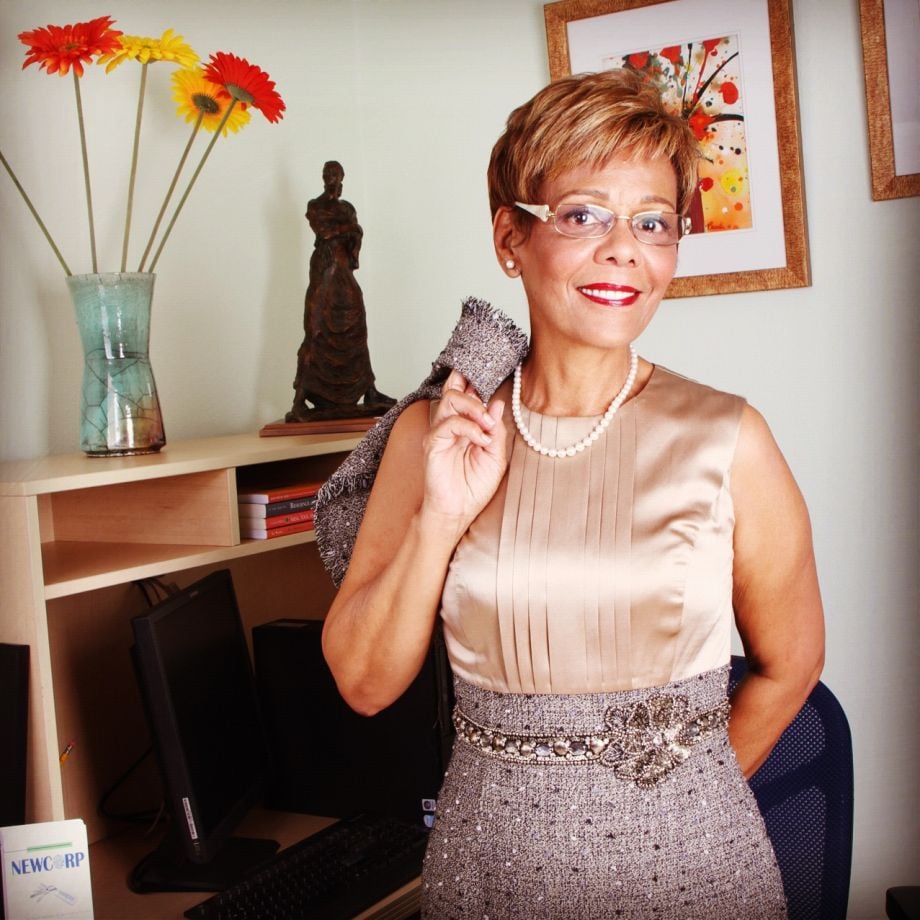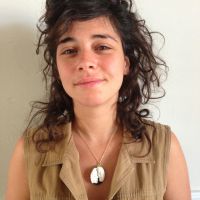Are You A Vanguard? Applications Now Open
This is your first of three free stories this month. Become a free or sustaining member to read unlimited articles, webinars and ebooks.
Become A MemberThe suburban area of New Orleans East is, like it sounds, about 15 minutes east of New Orleans. To get there from the city, you hop on Interstate 10 and cruise over the industrial canal, where smells of coffee roasting abound. You’ll pass the eerie, post-apocalyptic wooden structures of an abandoned Six Flags theme park, where the entrance marquee still reads, “Closed for Storm.” After a string of similarly abandoned strip malls and windswept motels, you’ll arrive at a surprisingly bustling shopping center, where all the business names are written in Vietnamese. You’ll pass by a narrow canal, and notice a patchwork of vegetable gardens growing in the yards that back up to its banks. One of those gardens belongs to Richard Nguyen.
Like many southern Vietnamese, he came to New Orleans after the fall of Saigon in 1975. The local archdiocese welcomed refugees with open arms, and it was relatively easy for them to adjust in Southeastern Louisiana; the climate was similar to what they were used to, as was the industry. New immigrants grew vegetables and found work in the Gulf Coast’s booming seafood industry on docks and shrimping boats or in distribution. Because they settled in concentrated and relatively isolated areas like New Orleans East, many of them could get by without having to learn to speak English. The community became tight-knit — an economy and culture unto its own. When Hurricane Katrina hit in 2005, New Orleans East flooded and many people lost everything: homes, businesses and even family members. Richard Nguyen’s mechanic shop was one of those completely wiped out. With the support of his community, he and many others rebuilt new businesses and homes. They had survived the fall of Saigon, and they could survive Katrina too.
What no one anticipated was the next challenge: the BP oil spill. When the Deepwater Horizon oil rig exploded on April 20, 2010, one in three fishermen in the Gulf region was Vietnamese. The 200-million-plus gallons of oil that gushed into the Gulf of Mexico devastated the fishing industry — over a third of U.S. waters in the Gulf were closed off to commercial fishing resulting in a $2.5 billion loss for the industry. It took a year before all 88,000 miles were reopened.
With a third of the Southeast Asians along the Gulf Coast (about 40,000 people) employed in the seafood industry, the community had to come together once again, this time to reevaluate its economic distribution and dependency on the Gulf.
Daniel Nguyen (no relation to Richard) is a young Vietnamese-American organizer who works for Mary Queen of Vietnam Community Development Corporation, the nonprofit arm of a local Catholic church. The church is an anchor for the Vietnamese community in New Orleans and played a critical role in its resurgence after Katrina. The post-storm recovery would prove to be practice for the catastrophe that would come five years later when BP’s oil stained the water that had become the community’s lifeblood.
Daniel Nguyen said that the spill didn’t just ruin jobs, it shook the community’s entire subsistence economy. It wasn’t just fishermen who relied on fish; in a community that still used bartering and trade techniques, seafood was currency unto itself.
“For example, if you’re a shrimp boat captain and you harvest 100 pounds of shrimp, you would sell maybe 75 pounds to the market and 25 pounds you would keep back to feed your family, or barter with other community members,” he says. “So a [shrimp] farmer may not have time to hone his carpentry skills so he or she may pay a carpenter to fix his or her house in the form of seafood.”

In this June 30, 2010 photo, Tom Huynh looks out to a row of docked fishing boats, including his own. The Vietnamese fisherman couldn’t work on the water for a year following the oil spill. (AP Photo/Gregory Bull)
With this informal economy fueling the local community, the loss of a critical piece can be devastating to the whole network. Daniel and his fellow organizers started asking around to see what people needed to get on their feet.
“We started organizing fishing folks, but what we found was that a lot of people were growing produce to supplement the cost of living,” he recalls.
Daniel Nguyen says he found that people practicing subsistence farming were growing in excess; even after feeding themselves and their families, they had leftover produce. In the meantime, a lot of other folks had nothing.
One silver lining of seasoned experience with disaster response is that you get good at organizing. In the summer of 2010, just months after the oil spill, the Vietnamese community in New Orleans East put together a summit comprised of the community members most affected by the spill. The central concerns to come out of the summit were economic sustainability, poverty and food access. (Until a Walmart opened last year, there was one supermarket to serve the 70,000 residents of New Orleans East.)
The community decided that the best solution to address these concerns was to develop a sustainable agriculture model that could create jobs, address the problem of food access and leverage skills that many community members already have. After debate about the best way to do this, the structure they settled on for this new endeavor was a cooperative business. Structuring it as a co-op would distribute the labor, and prevent community members from growing in excess and from competing with one another. It was a sharing economy built from the ground up.
One of the first people to join the co-op was Richard Nguyen. The disasters had wiped out his autobody shop, and he was ready to reconsider his line of work.
“Back in my homeland I worked on a big farm growing mostly coffee and vegetables,” explains Richard, “so when VEGGI farmers cooperative was formed I found that it was more suited to my abilities and skills and talents.”
A Tour of the VEGGI Co-Op Farm
Daniel Nguyen says that while the co-op made perfect sense on paper, organizing growers was a different story. He didn’t anticipate how difficult it would be to convince refugees of a former Communist regime to buy into a communal financial structure.
“Building community is one thing, but once you put money into it, people felt like that would be really complicated and not possible to have so many hands in the pot,” Daniel says.
The only way to convince people to join up was to show them that it worked — that member growers were bringing in revenue. Daniel says that for some growers, the co-op is highly lucrative.
“So for example our highest-income-generating grower right now probably generates $50,000 a year,” he says.
Daniel says they also had to be careful to use the right terminology to make sure recruitment language doesn’t ring true of Communist systems that many refugees are wary of. But there are some undeniable conceptual similarities.
“One of the principles in which we organize or build the cooperative around is this idea of ‘from each according to ability’ and ‘to each according to need,‘” he says.
Not everyone uses the co-op as their bread and butter. Here’s how it works: Each member gets some startup costs covered. They don’t pay for seeds, for infrastructure like irrigation, or in many cases, for land. The co-op distributes and markets the grower’s produce to local buyers. In return, it takes a cut off the top. Growers receive a return on the produce sold based on how much land they cultivate; if you grow an acre’s worth of food, you’ll get a higher percentage of the profits than someone whose plot is only the size of a backyard. Daniel says 80 percent of the profits go back to the growers, and the remaining 20 percent goes to operational costs. They have about nine grower-members right now, and their growth is limited based on their access to land for farming.
Richard Nguyen says he’s grateful for the co-op for its expanded distribution reach. He says the biggest obstacle keeping him from selling his own produce is the language barrier.
“So we are people who know how to grow produce and can, but we don’t know how to talk to buyers,” he told me through an interpreter.
VEGGI expands the market pool that growers can access dramatically. I recently went with Daniel on a delivery route, dropping off homemade tofu from the co-op everywhere from a vegan Brazilian cafe to an artisanal doughnut shop.
Talking to Daniel on the VEGGI Co-Op Delivery Route
New Orleans East isn’t the only community using a co-op model as a way to pool resources. There are hundreds of businesses registered as co-ops across the country and there have been for decades. The majority, however, are credit unions, housing organizations or grocery stores in smaller cities with a large population of college-educated residents, often university towns like Madison, Wisconsin, or Ithaca, New York. Those that are in larger cities are typically in liberal, coastal cities such as Seattle, Olympia, Brooklyn, Philadelphia and Portland. Now emerging is a growing interest in place-based co-ops that work, like VEGGI, with urban populations toward an explicit goal of creating jobs and wealth in a specific community. What cooperatives can offer member-owners that another small business doesn’t typically offer employees is a direct stake in future growth. They provide a structure to keep profits within communities, and generate equity for the people who live and work there.
Ted Howard directs the Democracy Collaborative, a research and advisory group based out of Washington and Cleveland, dedicated to community wealth-building. He says it makes sense that it’s taken a while for the cooperative idea to catch on in urban areas, but that doesn’t mean it won’t work.
“The way co-ops are typically developed, in Berkeley or Brooklyn, 10 people maybe want to start a bakery. So they get together and they each put in their own capital,” Howard says.
But that can’t work in the types of neighborhoods he’s looking at in downtown Cleveland, where the median income for a family of four is $18,500, well below the national poverty line.
“It needs a bigger team of people to build the business because the workers don’t have the capital,” Howard says.
John McMicken directs the Evergreen Cooperative network in Cleveland, where three member-owned cooperatives contract with the city’s largest companies — hospitals and universities — to offer goods and services and create job growth. McMicken says the economic problems in downtown Cleveland are about more than just creating jobs, and co-ops in particular are well suited to sustainable, big-picture solutions.
“It was an effort to move beyond just job creation into what we call wealth creation, in that our employees on a daily basis are earning equity where they work,” he says.

Crew leader Lekesha Chandler transplants lettuce at the Green City Growers Cooperative in Cleveland, one of the three Evergreen co-op businesses. (AP Photo/Tony Dejak)
Evergreen runs a laundry facility, a solar company and a hydroponic lettuce farm. McMicken says member-owners are more invested because of their ownership stake.
“As an owner, quality of work, customer service — whatever impacts the company’s bottom line impacts their own bottom line,” he explains.
McMicken says on top of income, he’s seen the model generate a tremendous amount of pride in member-owners from the ability to earn equity. The opportunity can feel especially meaningful in neighborhoods that have suffered from disinvestment.
“If I’m somebody whose mom and grandma grew up here, I can now work here and put wealth back in my community,” McMicken says.
Evergreen runs a laundry facility, a solar company and a hydroponic lettuce farm. McMicken says member-owners are more invested because of their ownership stake.
For cities, co-ops also offer an alternative to mainstream economic development strategies that have local governments caught in costly bidding wars for corporations that won’t invest in a community without tax breaks and big subsidies.
“There’s a growing disenchantment around the country with traditional economic development that has often focused on bundling up a lot of public resources to almost offer a bribe for a company,” Howard says.
Howard says that local governments are sick of giving tax credits, capital assets and other assistance to companies, only to see them relocate when they get a better deal someplace else.
“Imagine if you and I and 40 other people all owned the place where we worked; it’s very unlikely someone will stand up and say let’s all go to China,” he says. “So the idea of investing in co-ops that are by intention loyal to a community, that’s of interest.”
The City of Rochester in upstate New York knows the pitfalls of your standard corporate-led model all too well. Today, one of the nation’s poorest cities, Rochester flourished through the 20th century as a manufacturing and research hub, home to Eastman Kodak, Xerox and Bausch & Lomb. Yet over the last 25 years, Kodak — once the giant of the three — has eliminated nine of every 10 jobs it had in the city and others have shrunk their local footprint too, leaving hulking plants empty in once-bustling neighborhoods. Knowing that the city can no longer depend on a corporate benefactor to keep it going, Rochester Mayor Lovely Warren recently brought in the Democracy Collaborative to help the city develop a plan to bring the city its own Evergreen-like business. “In Rochester, our co-ops will be located in distressed neighborhoods and employ neighborhood residents using a proven model that we know works,” Warren said in her State of the Union address at the beginning of the year.
Back in New Orleans, another group is hoping to leverage the cooperative model’s capacity for wealth creation a step further, to see if co-ops can work to sustain cultural economies as well.
A few times a year, most notably on Mardi Gras day, the New Orleans Mardi Gras Indians march through the city’s neighborhoods outfitted in bright, colorful suits made of beads and feathers. They beat drums and tambourines and chant through the streets. The Indians organize themselves by tribes. They construct new suits each year and sew the intricate patterns themselves by hand. Their street processions are part performance art, part turf war, part fashion show.
Mardi Gras Indian suits take hundreds of hours to hand-sew and bead.
Since Hurricane Katrina, television shows like HBO’s “Treme” have brought the Indians’ culture to a national stage. As with many of the cultural icons or traditions emblematic of New Orleans, the Mardi Gras Indians are attractive to outsiders because they are unlike anything you will see elsewhere and even with their heightened public status, they remain non-commercial and outside of mainstream culture. You feel special just to be in their presence.
But with increased popularity has come increased exploitation. In 2008, Louisiana’s Abita Brewing Company approached world-renowned Big Chief Darryl Montana about using his image to promote its new beer, Jockamo IPA. They offered Montana $500 for a day-long photo shoot and ongoing use of his image in promotional materials and online. Industry analysts at the time estimated that an endorsement deal of this size should average around $8,500. Montana declined the offer.
It’s not only corporations who benefit from the Indians’ likeness. Many photographers capture their image without giving credit or proceeds to the artists who create the intricately hand-sewn suits.
Mardi Gras Indian Rukiya is an artist and a queen with the Creole Wild West. She says the difference between appreciation and exploitation is when photographers don’t acknowledge that the suits themselves are works of art.
“The photographers come out there, they’re like ‘well I’m an artist too.’ No you’re not. You’re an event photographer. You didn’t make this,” she says.
As Indians have gained popularity, they’ve increasingly struggled with proprietary issues like these. In 2011, Mardi Gras Indians began working with entertainment lawyers to register their suits for copyrights. Now, some even bead copyright symbols into their suits.
Vaughn Fauria runs NewCorp, a community development corporation that provides technical and financial assistance to small and disadvantaged businesses in New Orleans. She says that though the black Mardi Gras Indians are an enormous draw for tourists, they claim very few of the financial rewards.
“They were in fact an economic catalyst, but they receive none of the economic benefit,” says Fauria. “They were exploited to the extent that they became consumers in their own trade.”

NewCorp Executive Director Vaughn Fauria, pictured here, has organized the Mardi Gras Indian Co-Op in hope of building a model to sustain the black artists who keep the Indian tradition alive. (Photo credit: NewCorp)
NewCorp serves as the convener of the nascent Mardi Gras Indian Co-op, which first began meeting in 2013 with seven tribes at the table. Now, Fauria says they have 14 regular members and up to 27 tribes involved. Over a period of time, each member is expected to contribute $3,000, which, Fauria explains, will ultimately generate a return.
“Eventually you’ll be able to collect on this investment as you would a royalty,” she says.
Members can sell and distribute their artwork through the co-op in exchange for a 20 percent overhead fee. A portion of that fee can go toward paying off your dues so none of that comes out of pocket.
Though still in its strategic planning phase, the co-op has already seen some success. They have a web portal with suits for sale, and they have them on display at a booth this coming weekend at the New Orleans Jazz and Heritage Festival. The co-op is brokering partnerships with hotels that commission displays, and is working with local museums like the Ogden Museum of Southern Art and the National WWII Museum to show member work. Before going up for sale, each piece goes through a formal evaluation process to determine its authenticity. For a suit to be deemed authentic, it must have been worn by a Mardi Gras Indian who made it him or herself and has been masking for more than three years. It’s then decided whether or not the piece is museum quality.
“We’re asking for top dollar,” says Fauria, “we’re not asking for this as if it’s a nickel-and-dime store.”
Rukiya’s Suit
Rukiya recently sold elements off of her suit to a local collector for $1,200; a breast plate that was on display at the Jazz Fest was sold to a collector from Chicago for $2,500. (Last year, the full suits were listed for $15,000 but none sold.)
Making suits is expensive. Rukiya says she spent at least $1,000 on materials last year, and that’s not taking into account the hours of labor it takes to sew by hand. Fauria says there isn’t the same communal attitude toward pooling resources there once was.
“It used to be such a community-driven thing. The legacy was carried on because everybody in the community made sure that everybody got theirs and would have,” she says. “Our communities are not that well-equipped anymore. Poor people are not poor in the same way that they used to be ….”
Rukiya hopes that the cooperative will work to re-instill some of the communal approach to the cultural practice, while at the same time keeping economic sustainability at the center.
“I gotta pay light bills and I gotta buy food,” she says, “but if I already got that, I can say ‘put that (money) toward the co-op.‘”
McMicken in Cleveland says quality is of the utmost importance when working with small businesses. Worker-owned cooperatives might get an automatic foot in the door by virtue of their arrangement, but they still have to prove themselves. He’s operating on a larger scale but the principle remains the same.
“We’ll have buy in and commitment on the CEO level,” he says, “but that doesn’t mean that the procurement manager is ready to be doing business with us that day. And by the way, we still have to have a competitive price and deliver quality. These larger corporations don’t have time to play around with a fledgling operation.”
While co-ops like the Mardi Gras Indians and VEGGI are operating on a smaller scale than big networks like Evergreen, they offer a good starting point for New Orleans. In New Orleans, only 48 percent of working-age black males are employed. In his economic development strategy released last fall, New Orleans Mayor Mitch Landrieu committed to creating a worker-owned cooperative that connects job seekers to employment by leveraging anchor institutions — just like in Cleveland.
Ted Howard and the Democracy Collaborative recently completed a preliminary study researching the feasibility of the medical industry in New Orleans to procure goods and services from small, local businesses — and to see if there’s potential for any of those small businesses to work as co-ops.
In a place as focused on exceptionalism and preservation as New Orleans, it makes sense that an economic model for wealth creation would first take root in the city’s most tightly knit and culturally unique communities. Now, as government officials aim to address unemployment on a larger scale, they may find themselves looking to groups like the Mardi Gras Indians to lead the way.
Our features are made possible with generous support from The Ford Foundation.

Nina Feldman is an independent journalist focused on audio production. She worked as a regular contributor to NPR member station WWNO in New Orleans and as editor at American Routes. Her work has also appeared on Marketplace, Morning Edition and PRI's The World.

20th Anniversary Solutions of the Year magazine